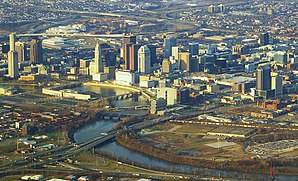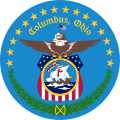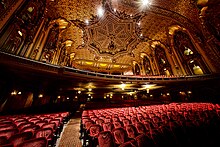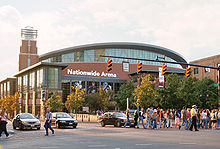Columbus (Ohio)
| Columbus | ||
|---|---|---|
| Nickname : The Arch City, The Discovery City, C-Bus | ||
 Downtown Columbus with the Scioto River |
||
 seal |
 flag |
|
| Location in Ohio | ||
|
|
||
| Basic data | ||
| Foundation : | 1812 | |
| State : | United States | |
| State : | Ohio | |
| Counties : |
Franklin County Delaware County Fairfield County |
|
| Coordinates : | 39 ° 58 ′ N , 83 ° 0 ′ W | |
| Time zone : | Eastern ( UTC − 5 / −4 ) | |
|
Inhabitants : - Metropolitan Area : |
860,090 (as of 2016) 2,041,520 (as of 2016) |
|
| Population density : | 1,579.3 inhabitants per km 2 | |
| Area : | 550.5 km 2 (approx. 213 mi 2 ) of which 544.6 km 2 (approx. 210 mi 2 ) is land |
|
| Height : | 275 m | |
| Postal code : | 43085 | |
| Area code : | +1 614 | |
| FIPS : | 39-18000 | |
| GNIS ID : | 1080996 | |
| Website : | www.columbus.gov | |
| Mayor : | Andrew Ginther (D) | |
 Columbus |
||
Columbus is the capital of the US state Ohio and its largest city with around 860,000 inhabitants (2016 estimate, US Census Bureau ). Founded in 1812 at the confluence of the Scioto and Olentangy rivers , the city is located in the geographic center of the state and is also the county seat of Franklin County .
The main campus of Ohio State University is in Columbus. It is one of the largest contiguous higher education centers in the United States . The state government and the university dominate the city. Columbus is home to many sports teams.
climate
| Columbus, Ohio | ||||||||||||||||||||||||||||||||||||||||||||||||
|---|---|---|---|---|---|---|---|---|---|---|---|---|---|---|---|---|---|---|---|---|---|---|---|---|---|---|---|---|---|---|---|---|---|---|---|---|---|---|---|---|---|---|---|---|---|---|---|---|
| Climate diagram | ||||||||||||||||||||||||||||||||||||||||||||||||
| ||||||||||||||||||||||||||||||||||||||||||||||||
|
Average monthly temperatures and rainfall for Columbus, Ohio
|
|||||||||||||||||||||||||||||||||||||||||||||||||||||||||||||||||||||||||||||||||||||||||||||||||||||||||||||||||||||||||||||||||||||||||||||||||||||||||||||||||||||
History and culture
The construction of the city - which was chosen by politicians as the capital before it even existed - was carried out by a group of investors from Franklinton , who offered the state land near the Scioto River to build the city there.
In the years 1833 and 1849/50 the city was hit by cholera epidemics, which killed over 600 people. At the same time, Columbus found improved traffic connections. A new canal connected the city to the existing Ohio-Erie Canal , and in 1831 the National Road (also called Cumberland Road ) reached Columbus. In 1850, the city was then connected to the railway network via the Columbus and Xenia Railroad . Due to the improved transport connections, Columbus prospered and around 1850 had around 18,000 inhabitants. In 1850, Capitol University was the city's first college .
One of the thriving industries in Columbus was the manufacture of carriages . By the end of the 19th century, the city had more than twenty companies producing carriages, so one sixth of all carriages produced worldwide came from Columbus. This earned the city the nickname Buggy Capital of the World .
One of the most popular residential areas in the city is the German Village , built in the 19th century by German immigrants. At times, the German population made up a third of the city of Columbus. During the First World War, when the mood in the USA was directed against German immigrants, and during Prohibition , when the breweries had to be closed, the German Village experienced its decline. In the 1960s, parts of the district were demolished to make way for new construction projects. However, this led to a private rescue initiative by residents, so that today the German Village is the largest historic district in the USA in the "National Register of Historic Places", the preservation of which is financed from private funds. Linden is one of the oldest quarters .

The National Park Service has three National Historic Landmarks for Columbus : the Captain Edward V. Rickenbacker House , the Ohio Statehouse, and the Ohio Theater . 149 buildings and sites in the city are listed on the National Register of Historic Places (NRHP) (as of November 9, 2018).
Demographics
According to the 2000 census , the city has 711,470 inhabitants, 301,534 households and 165,240 families. The population density is 1,306.4 / km². The population is 67.93% White, 24.47% African American, 0.29% Native American, 3.44% Asian, 0.05% Pacific Islander, 1.17% Other, and 2.65% Mixed Ethnicity . 2.46% are Latinos.
Of the 301,534 households, 28.0% have children under the age of 18. 36.1% of them are married and cohabiting couples, 14.5% are single mothers, 45.2% are not families. 34.1% of all households are made up of singles, 7.0% are single people over 65. The average size of households is 2.30. The average family has 3.01 people.
24.2% of the population are under 18, 14.0% between 18 and 24, 35.1% between 25 and 44, 17.9% between 45 and 64, 8.9% over 65 years. The median age is 31 years. The ratio between women and men is 100: 94.6. For the age group over 18, the ratio is 100: 91.9.
The median income for a household is $ 37,897. The median income for a family is $ 47,391. Males have a median income of $ 35,138 and females $ 28,705. The per capita income for the city is $ 20,450. 14.8% of the population and 10.8% of families are below the poverty line. Of these people, 18.7% are under 18 years of age and 10.9% are over 65 years of age.
Columbus is considered a typical American city because of its population composition. Several companies test their latest products here first to gauge sales across America.
Population development
Columbus is one of the few major cities in Ohio (and in the entire Rust Belt ) whose population has not decreased, but has increased (even significantly) since 1980.
| year | Residents |
|---|---|
| 1980 | 564,871 |
| 1990 | 632.945 |
| 2000 | 711.470 |
| 2010 | 787.033 |
| 2016 | 860.090 |
¹ 1980–2010: census results; 2016: US Census Bureau estimate
Economy and Infrastructure
The metropolitan area of Columbus generated a gross domestic product of 130.8 billion US dollars in 2016, making it 29th among the metropolitan areas of the United States. The unemployment rate in the metropolitan region was 3.5 percent, which is below the national average of 3.8 percent. (As of March 2018).
The utility company American Electric Power and the retailer Limited Brands have their headquarters in Columbus .
Compuserve , online company and internet pioneer, was founded in Columbus and was based here until it was dissolved in 2009.
There are four airports in the city, the largest of which is Port Columbus International Airport .
- Port Columbus International Airport (IATA: CMH, ICAO: KCMH)
- Rickenbacker International Airport (IATA: LCK, ICAO: KLCK), u. a. important to the Ohio Air National Guard and as a cargo airfield
- Ohio State University Airport (IATA: OSU, ICAO: KOSU)
- Bolton Field Airport (ICAO: KTZR)
Sports
Professional sports teams
- Columbus is the hometown of the Columbus Blue Jackets ice hockey club , which plays in the NHL . The association was founded in 2000. The Blue Jackets play in the Nationwide Arena , which can seat 18,500 people. A former hockey team from Columbus are the Columbus Chill , who played in the East Coast Hockey League until the 1998/99 season .
- Columbus Crew is one of the ten founding members of Major League Soccer and won the 2008 championship.
- In the Arena Football League (AFL) Columbus was represented by the Columbus Destroyers until 2008 . They also played in the Nationwide Arena .
- The Columbus Clippers represent their hometown in minor league baseball . The home games were played at Cooper Stadium from 1977 to 2008 , from then on the team moved to the new Huntington Park baseball stadium, which opened in 2009.
Sports facilities
The largest stadium in Columbus is Ohio Stadium . It holds 104,944 spectators and is home to the Ohio State Buckeyes college football team . The stadium itself was built from 1921 to 1922. The last renovation was in 2014. In addition to the sporting, concerts and other events are also held here.
The Columbus Crew Stadium , with a capacity of 20,150 spectators, was the first soccer-specific stadium in the United States. The home games of Columbus Crew SC have been played here since 1999.
The Value City Arena at The Jerome Schottenstein Center is the largest multi-purpose hall in the city. The owner is Ohio State University , on whose campus the arena is located. The college team's basketball and ice hockey games are played here.
The Nationwide Arena is another multi-purpose hall in Columbus and venue of the Games of the Columbus Blue Jackets. Basketball games and concerts were also held here.
Huntington Park baseball stadium opened in 2009 and is home to the Columbus Clippers.
Town twinning
Columbus maintains city partnerships with the following cities :
Personalities
sons and daughters of the town
- Granville T. Woods (1856-1910), inventor
- Frederick Clarence Weber (1878–1980), chemist
- Edward Vernon Rickenbacker (1890–1973), racing car driver, entrepreneur and fighter pilot in the First World War
- James Thurber (1894–1961), writer
- Curtis E. LeMay (1906–1990), General in the US Air Force, Commander in Chief of Strategic Air Command
- Arthur M. Schlesinger (1917–2007), historian
- Robert Atkins (1930-2003), cardiologist and nutritionist
- Donn Eisele (1930–1987), astronaut, flew into space with Apollo 7
- Jack Nicklaus (born 1940), golfer
- James Douglas (* 1960), world heavyweight boxing champion
- Foley (* 1962), funk and fusion musician
- Josh Radnor (born 1974), actor
- Tero Smith (1977-2008), rapper and music producer
- Lilia Osterloh (* 1978), tennis player
- Chris Leitch (* 1979), soccer player
- Scott Seiver (born 1985), poker player
- Andrea Bowen (* 1990), actress
- Kenny Stafford (* 1990), American football, arena football and Canadian football player
Personalities who have worked on site
- Frances Alice Kellor (1873–1952), sociologist and social reformer
- Ted Williams (born 1957), radio host
- Margaret Peterson Haddix (born 1964), writer
- Maggie Grace (born 1983), actress
Music bands
- OAR (founded 1996), rock band
- Rascal Flatts (formed in 2000), country band
- Early Man (founded in 2003), heavy and thrash metal band
- Twenty One Pilots (founded in 2009), music duo
- Like Moths to Flames (founded 2010), metalcore band
- Beartooth (founded in 2012), hardcore band
literature
- Bob Hunter: A Historical Guidebook to Old Columbus: Finding the Past in the Present in Ohio's Capital City. Ohio University Press, Athens 2012, ISBN 978-0-8214-2012-6 .
- Alfred E. Lee: History of the city of Columbus, capital of Ohio , Vol. 1, Publisher: WW Munsell & Co, New York & Chicago, 1892
- Alfred E. Lee: History of the city of Columbus, capital of Ohio , Vol. 2, Publisher: WW Munsell & Co, New York & Chicago, 1892
Web links
swell
- ↑ Jeffrey T. Darbee and Nancy A. Recchie: The AIA Guide to Columbus , Ohio University Press, Athens, 2008, page XIX
- ^ Jacob Henry Studer: Columbus, Ohio / Its history, resources, and progress , Verlag Henry Studer, 1873, pp. 373-376
- ^ A b Nellie Kampmann: A haunted history of Columbus Ohio , Haunted America / A Division of the History Press, 2011, ISBN 978-1-60949-087-4 , p. 16
- ↑ List of NHL by State . National Park Service , accessed November 9, 2018.
- ↑ Search mask database in the National Register Information System. National Park Service , accessed November 9, 2018.
- ↑ 1980–2010: Census Results
- ^ US Department of Commerce, BEA, Bureau of Economic Analysis: Bureau of Economic Analysis. Retrieved July 4, 2018 (American English).
- ^ Columbus, OH Economy at a Glance. Retrieved July 5, 2018 .
- ^ Columbus Sister Cities International , accessed June 2, 2017


